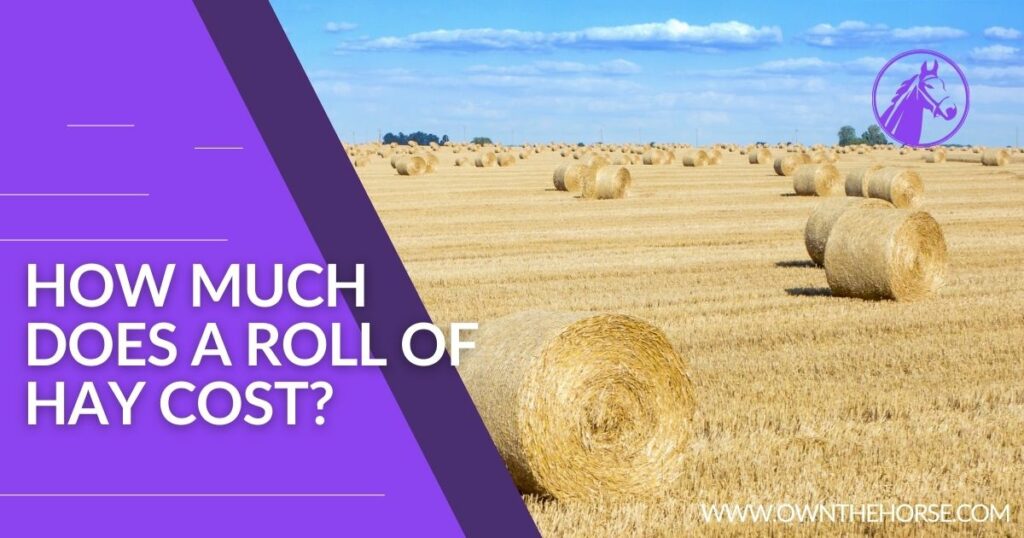As an Amazon Associate we earn from qualifying purchases.
Welcome to our comprehensive guide on hay pricing and how much does a roll of hay cost. If you’re a farmer, equestrian enthusiast, or someone in need of hay for livestock, understanding the cost of hay is essential. In this guide, we will delve into the various factors that influence hay pricing, helping you make informed decisions and find the best deals on the market.
| Form/Size | Average Price |
|---|---|
| Small Square Bale | $4 – $10 per bale |
| Large Square Bale | $50 – $150 per bale |
| Round Bale | $20 – $150 per bale |
| Haylage Bale | $40 – $60 per bale |
| Hay Cubes (Ton) | $250 – $340 per ton |
Please note that prices can vary depending on location, type of hay, and other factors. These are just general price ranges and may not be accurate for all regions.
- Convenient compact size roughly 6x6x12
- This hay provides for your pet’s many needs, from dental care, to play time, and is additive and preservative free
- Easy to feed for a convenient mealtime!
- Packaging may vary
- 100% Organic Prairie
Prices pulled from the Amazon Product Advertising API on:
Product prices and availability are accurate as of the date/time indicated and are subject to change. Any price and availability information displayed on [relevant Amazon Site(s), as applicable] at the time of purchase will apply to the purchase of this product.
For our full guide to what is costs to care for a horse click this link.
Average Price of a Roll of Hay
The price of hay can vary widely depending on the size and type of bale that you’re looking for. Round bales or rolls typically range from $30 to $100, while larger square bales can cost anywhere from $70 to $200. However, hay is not always priced on an individual bale scale. If you’re in the market for multiple bales, considering going by the ton. While this number changes from region to region, you can usually purchase hay by the ton for between $100-200. So whatever your hay needs are, do your research to get the best deal for your pocketbook.
Understanding Hay Pricing Factors
Hay pricing can vary significantly based on a range of factors. By understanding these factors, you can navigate the market with confidence and find hay that meets your needs at a competitive price.
1. Hay Type and Quality
The type and quality of hay play a crucial role in determining its price. Hay comes in various types, such as Timothy, Bermuda, Alfalfa, and Clover. Each type has its own nutritional profile and suitability for different livestock or purposes. Generally, premium-quality hay, which is rich in nutrients and has minimal dust or mold, will command a higher price than lower-grade alternatives.
2. Harvesting and Production Costs
The cost of producing hay can vary based on factors like labor, equipment, fuel, and land expenses. If the production process involves additional steps, such as drying or baling, these costs may also impact the final price. Furthermore, weather conditions can affect the yield and quality of hay, potentially leading to price fluctuations.
3. Supply and Demand
The basic principles of supply and demand also apply to hay pricing. When the supply of hay is high and demand is low, prices may decrease. Conversely, if hay is in short supply or demand spikes, prices can rise. Factors such as seasonal variations, geographic location, and economic conditions can influence the balance between supply and demand.
4. Transportation and Delivery Costs
Transportation and delivery costs are additional considerations that affect the final price of hay. If you’re purchasing hay from a distant location, you may incur higher shipping expenses. Additionally, the availability of reliable transportation services can impact overall costs, especially for bulk orders.
How Much Does a Roll of Hay Cost – Pricing Trends
As we delve into the year 2023, several trends emerge regarding hay pricing. It’s important to stay updated with these trends to ensure you’re well-informed when purchasing hay.
1. Fluctuating Weather Conditions
Weather patterns have a direct impact on hay production, and 2023 is no exception. Unpredictable weather events such as droughts, floods, or extreme temperatures can disrupt crop yields and drive up prices. Farmers and buyers alike must be prepared for potential fluctuations in hay availability and pricing due to weather-related challenges.
2. Increased Demand for Organic Hay
In recent years, there has been a growing demand for organic hay due to its perceived health benefits and environmental sustainability. As consumers increasingly prioritize organic and natural products, the demand for organic hay is expected to rise. Consequently, organic hay prices may be higher compared to conventionally grown hay.
3. Online Marketplaces and E-commerce
The rise of online marketplaces and e-commerce platforms has made it easier than ever to buy and sell hay. This increased accessibility and competition can lead to more transparent pricing and a wider range of options. Online platforms allow buyers to compare prices, read reviews, and connect with sellers directly, empowering them to make informed purchasing decisions.
4. Local and Regional Hay Exchanges
Local and regional hay exchanges have gained popularity as a means of connecting buyers and sellers within specific geographic areas. These exchanges promote community engagement and reduce transportation costs. By participating in such exchanges, buyers can often find locally sourced hay at competitive prices.
Where to Buy Rolls / Bales of Hay Online
Rolls of hay from Allhay.com are the perfect choice for any USA-based hay purchaser! Not only doAllhay.com offer a unique variety of hay that will meet your needs, but they also offer the convenience of shopping from the comfort of your own home. Not only do they ship hay to all fifty states in the USA, but they also offer timely delivery, the freshest hay available, and competitive prices so you get the most bang for your buck. So if you’re looking for an easy and convenient way to purchase high quality hay, then Allhay.com is the perfect choice!
Tips for Finding Affordable Hay
Now that we’ve covered the various factors and trends influencing hay pricing, let’s explore some valuable tips to help you find affordable hay without compromising on quality.
1. Research Local Suppliers
Start by researching local suppliers in your area. Local farmers or hay producers often have competitive prices due to reduced transportation costs. Check online directories, agricultural forums, or reach out to agricultural associations to find reliable suppliers near you. Visiting local farmers’ markets or attending agricultural fairs can also provide opportunities to connect with hay suppliers directly.
2. Buy in Bulk
Consider purchasing hay in bulk to save money in the long run. Many suppliers offer discounted rates for large orders, allowing you to stock up and potentially negotiate better prices. However, make sure you have adequate storage facilities to maintain the quality of the hay over time.
3. Collaborate with Other Buyers
Pooling resources and collaborating with other hay buyers can be an effective way to reduce costs. Consider forming a cooperative or joining existing agricultural groups in your area. By purchasing hay collectively, you can benefit from bulk discounts and shared transportation expenses, ultimately lowering the overall cost.
4. Seasonal Buying
Keep an eye on seasonal fluctuations in hay prices. Prices may vary throughout the year due to factors like harvest timing and demand. For example, buying hay in the offseason or during periods of abundant supply can often result in more favorable pricing. Stay informed about local hay production cycles to identify the best time to make your purchase.
5. Consider Alternative Hay Sources
Explore alternative hay sources beyond traditional suppliers. Some farmers or landowners may have surplus hay or fields available for lease. Building connections with local agricultural communities can uncover hidden opportunities for acquiring hay at competitive prices. Additionally, consider reaching out to nearby livestock farms or equestrian centers that may have excess hay they are willing to sell.
6. Quality Assurance
While seeking affordable hay, it’s essential to prioritize quality. Poor-quality hay may be cheaper initially, but it can lead to health issues and lower feed efficiency for your animals. Inspect the hay for signs of mold, dust, or weeds. If possible, request a hay analysis to evaluate its nutritional value. Investing in higher-quality hay will benefit your livestock’s health and overall productivity in the long run.
7. Build Long-Term Relationships
Developing long-term relationships with hay suppliers can be advantageous. Establishing trust and loyalty with reliable suppliers may result in better pricing, personalized advice, and priority access to high-quality hay. Regular communication and consistent purchases can help foster these relationships over time.
By considering these tips, you can navigate the hay market more effectively and find affordable options without compromising on quality.
SEE ALSO : How Many Alfalfa Cubes Equal a Flake of Hay?
How Much Does A Roll Of Hay Cost – Final Thoughts
In conclusion, understanding the factors and trends that influence hay pricing is crucial for making informed decisions when purchasing hay. By considering hay type and quality, production costs, supply and demand dynamics, and transportation expenses, you can gain a comprehensive understanding of the pricing landscape.
Additionally, staying updated on the latest trends, such as fluctuating weather conditions, increased demand for organic hay, the rise of online marketplaces, and the presence of local hay exchanges, can provide valuable insights and opportunities for finding competitive prices.
Remember to utilize tips such as researching local suppliers, buying in bulk, collaborating with other buyers, considering seasonal variations, exploring alternative sources, ensuring quality assurance, and building long-term relationships. These strategies will help you find affordable hay that meets your specific requirements.
Amazon and the Amazon logo are trademarks of Amazon.com, Inc, or its affiliates.

Hey there, I’m Jasmine! I’m a total horse fanatic and have been working with these amazing animals for as long as I can remember. I’m passionate about sharing my love for horses with others and helping them learn more about these majestic creatures. As a professional horse trainer and riding instructor, I’ve developed a deep understanding of equine science and am committed to the welfare of horses. That’s why I founded OwnTheHorse.com, a blog where I share my knowledge and insights with fellow horse enthusiasts. I love connecting with my readers and building a friendly community of horse lovers. Whether you’re a seasoned equestrian or just starting out, I’m here to help and inspire you. Above all, I’m a friendly and compassionate person who truly cares about the well-being of horses and their human companions.


